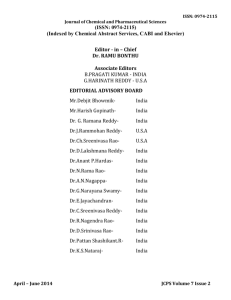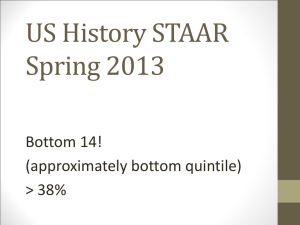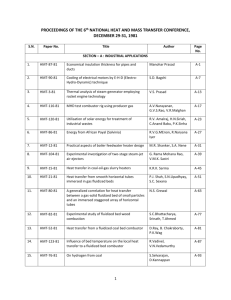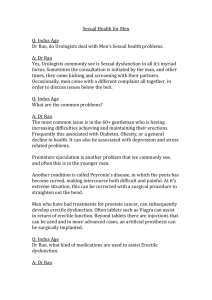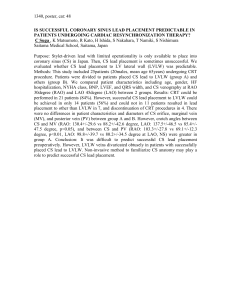DOC
advertisement
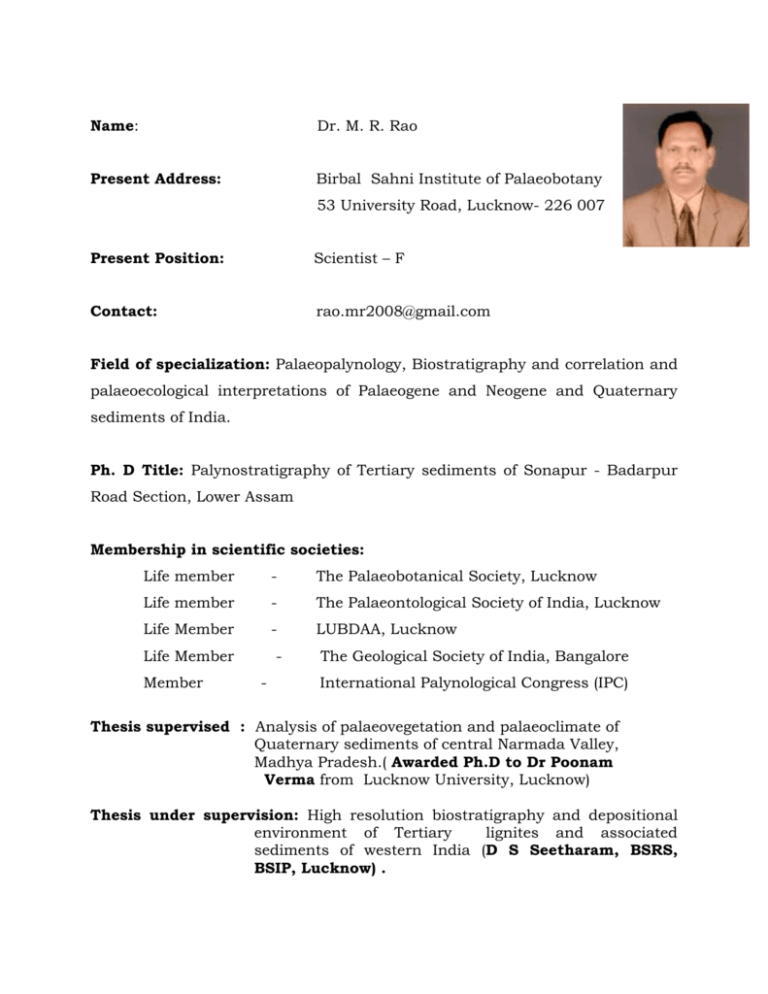
Name: Dr. M. R. Rao Present Address: Birbal Sahni Institute of Palaeobotany 53 University Road, Lucknow- 226 007 Present Position: Scientist – F Contact: rao.mr2008@gmail.com Field of specialization: Palaeopalynology, Biostratigraphy and correlation and palaeoecological interpretations of Palaeogene and Neogene and Quaternary sediments of India. Ph. D Title: Palynostratigraphy of Tertiary sediments of Sonapur - Badarpur Road Section, Lower Assam Membership in scientific societies: Life member - The Palaeobotanical Society, Lucknow Life member - The Palaeontological Society of India, Lucknow Life Member - LUBDAA, Lucknow Life Member Member - The Geological Society of India, Bangalore International Palynological Congress (IPC) Thesis supervised : Analysis of palaeovegetation and palaeoclimate of Quaternary sediments of central Narmada Valley, Madhya Pradesh.( Awarded Ph.D to Dr Poonam Verma from Lucknow University, Lucknow) Thesis under supervision: High resolution biostratigraphy and depositional environment of Tertiary lignites and associated sediments of western India (D S Seetharam, BSRS, BSIP, Lucknow) . Sponsored projects completed:/ Analysis of palaeovegetation and palaeoclimate of hominin bearing Quaternary sediments of central Narmada Valley, M. P. (DST Project No.SR/S4/ES-138/2005) DST Project- Monsoon intensification and Neogene-Quaternary Siwalik Biodiversity (M.R.Rao Co-PI; Dr Rajeev Patnaik, Project Investigator, DST Project No. SR/S4/ES/171-2005). Recent visit to abroad: Under the INSA Exchange of Scientists Programme between INSA, New-Delhi and CAS, Beijing, visited the Institute of Botany, Chinese Academy of Sciences, Beijing, China for a period of 27 days between 9th October to 4th November, 2011. Research Experience: 35 years and 3 Months Scientific Work-done: Specialized in the field of Tertiary and Quaternary 35 palynology and have years research experience at the Birbal Sahni Institute of Palaeobotany, Lucknow. The main pursuits of my study have been morphotaxonomy of sporepollen, establishment of palynostratigraphy and palaeoclimatic and palaeoenvironmental interpretations. My expertise particularly relates to palynology, palynostratigraphy and palaeoecological interpretations of Cretaceous-Tertiary and Quaternary sediments of India. The important basins worked out in India are: 1. Meghalaya-Assam (Oligocene to Early Miocene) 2. Kerala Basin (Early Eocene to early Miocene) 3. Cauvery Basin (Late Albian to Early Miocene) 4. Maharashtra (West coast lignites, Early Miocene) 5. Kartnataka (Early Miocene) 6. Himachal Pradesh (Siwaliks, Middle Miocene to Pliocene) 7. Haryana (Siwaliks, Middle Miocene to Early Pleistocene) 8. Central India (Hominin bearing Quaternary sediments, Late Pleistocene to Late Holocene) 9. Cambay Basin (Vastan Lignite Mine, Early Eocene......continued) 10. Kutch Basin (Palaeocene to Early Miocene....continued) At present, working under the Institute project (5.1) entitled “ High resolution biostratigraphy and depositional environment of Tertiary sedimentary sections of Kutch, western India” under XII Five year plan (2012-2017). LIST OF PUBLICATIONS 1. Rao, M. R. 1983. A new record of Malayaeaspora costata Trivedi, Ambwani & Kar from the Tertiary sediments of Meghalaya and Assam. Geophytology 13 (2): 241-242. 2. Singh, H.P & Rao, M. R. 1984. Surmaspora, a new pteridophytic spore genus recovered from the Tertiary sediments of Meghalaya and Assam. Curr. Sci., 53 (15): 803-805. 3. Saxena, R. K. & Rao, M. R 1984. Palynology of Barail (Oligocene) and Surma (Lower Miocene) sediments exposed along Sonapur Badarpur Road Section, Jaintia Hills (Meghalaya) and Cachar (Assam). Part. I Dinoflagellate cysts. Jour. Palaeontol. Soc. India. 29: 52 - 62. 4. Rao. M. R, Saxena, R. K.& Singh, H. P. 1985. Palynology of Barail (Oligocene) and Surma (Lower Miocene) sediments exposed along Sonapur Badarpur Road Section, Jaintia Hills (Meghalaya) and Cachar (Assam). Part. V. Angiospermous pollen grains. Geophytology 15 (1): 7 – 23. 5. Rao, M. R. 1986. Palynology of Barail (Oligocene) and Surma (Lower Miocene) sediments exposed along Sonapur Badarpur Road Section, Jaintia Hills (Meghalaya) and Cachar (Assam). Part. IV. Gymnospermous pollen grains. Geophytology 16 (1): 89 - 96. 6. Singh, H. P., Saxena, R. K. & Rao, M. R. 1986. Palynology of Barail (Oligocene) and Surma (Lower Miocene) sediments exposed along Sonapur - Badarpur Road Section, Jaintia Hills (Meghalaya) and Cachar (Assam). Part. II. Fungal remains. Palaeobotanist 35 (1): 93 - 105. 7. Saxena, R. K., Rao, M. R. & Singh, H. P. 1987. Palynology of Barail (Oligocene) and Surma (Lower Miocene) sediments exposed along Sonapur-Badarpur Road Section, Jaintia Hills (Meghalaya) and Cachar (Assam). Part. VI. Palynostratigraphic zonation. Palaeobotanist 35 (2): 150-158. 8. Rao, M. R. & Singh, H. P. 1987. Palynology of Barail (Oligocene) and Surma (Lower Miocene) sediments exposed along Sonapur - Badarpur Road Section, Jaintia Hills (Meghalaya) and Cachar (Assam). Part. III. Pteridophytic spores. Palaeobotanist 35 (3): 267 - 280. 9. Singh, H. P., Rao, M. R. & Saxena, R. K. 1987. Palynology of the Barail (Oligocene) and Surma (Lower Miocene) sediments exposed along Sonapur - Badarpur Road Section, Jaintia Hills (Meghalaya) and Cachar (Assam). Part. VII. Discussion. Palaeobotanist 35 (3): 331 - 341. 10. Saxena, R.K., Singh, H. P. & Rao, M. R. 1987. Palynology of the Tatrot Pinjor sequence exposed between Masol and Kiratpur in Ambala district, Haryana. Geophytology 17 (2): 270 - 284. 11. Rao, M. R. 1990. Palynological investigation of Arthungal bore -hole, Alleppey district, Kerala. Proceedings "Vistas in Indian Palaeobotany" Palaeobotanist 38 : 243 - 255. 12. Singh, H. P & Rao, M. R. (1990). Tertiary palynology of Kerala Basin- An overview. Proceedings “ Vistas in Indian Palaeobotany, Palaeobotanist 38: 256-262. 13. Singh, H. P., Saxena, R. K. & Rao, M. R. 1990. Recycled Permian and Cretaceous palynofossils from the Barail and Surma groups (Oligocene Early Miocene) in Jaintia Hills (Meghalaya) and Cachar (Assam). Geophytology 20 (1): 41-44 . 14. Rao, M. R. 1995. Palynostratigraphic zonation and correlation of the Eocene - Early Miocene sequence in Alleppey district, Kerala, India. Review of Palaeobotany and . Palynol. 86: 325-348. 15. Rao, M. R. 1995. Palaeoecological and stratigraphical significance of pteridophytic spores in the Kerala Basin. Indian Fern Journal 12: 97104. 16. Rao, M. R. 1995. Fungal remains from Tertiary sediments of Kerala Basin, India. Geophytology. 24: 233-236. 17. Rao, M. R. & Rajendran, C. P. 1996. Palynological investigation of Tertiary lignite and associated sediments from Cannanore, Kerala Basin. Palaeobotanist 43 (2): 63-82. 18. Rao, M. R. 1996. An Early Miocene palynofloral assemblage from Turavur bore-hole, Alleppey district, Kerala- its palaeoecological and stratigraphical significance. Geophytology 25: 155-163. 19. Venkatachala, B. S., Saxena, R. K., Singh, H. P., Kar, R. K., Tripathi, S. K. M., Kumar, M., Sarkar Samir., Mandal, J., Rao, M. R., Singh, R. S., Mandoakar, B. D. & Ambwani, K. (1996). Indian Tertiary angiospermous pollen: a critical assessment. Palaeobotanist 43 (2): 106-138. 20. Saxena, R.K. & Rao, M. R. 1996. Palynological investigation of the Boldamgiri Formation (Early Miocene) in type area, Garo Hills, Meghalaya. Geophytology 26 (1): 43-56. 21. Rao, M. R & Nair, K. K. 1998. Palynological investigation of the Miocene sediments exposed in Kannanellur-Kundara area, Quilon district, Kerala. Geophytology 27 (1&2): 49-59. 22. Rao, M. R. 2000. Palynological investigation of the Kherapara Formation (Oligocene) exposed along Tura-Dalu Road near Kherapara, West Garo Hills District, Meghalaya. Palaeobotanist 49 (2): 293-309. 23. Rao, M. R. 2001. Palynostrtigraphic zonation of the Tertiary sediments of Kerala Basin, India. In Goodman, D.K., and Clarke, R.T.(eds). Proceedings of IX International Palynological Congress, Houston, Texas, U.S.A 1996; American Association of Stratigraphic Palynologists Foundation, 277-289. 24. Rao, M. R. & Patnaik, R. 2001. Palynology of the Late Pliocene sediments of Pinjor Formation, Haryana, India. Palaeobotanist 50: 267-286. 25. Mandal, J. & Rao, M. R. 2001. Taxonomic revision of tricolpate pollen from Indian Tertiary. Palaeobotanist 50: 341-368. 26. Rao, M.R (2003). Sindhudurg Kalviwadithyrites, a new fungal genus from Formation, Sindhudurg District, Maharashtra. Palaeobotanist 52: 117-119. 27. Rao, M. R(2004). Palynological investigation of the Sindhudurg Formation exposed at Kalviwadi, Sindhudurg District, Maharashtra, India. Palaeobotanist 53: 123-135. 28. Rao, M.R. (2005). Reworked Permian and Cretaceous palynofossils from Miocene sediments of Mangalore, Karnataka, India. Journal of Geological Society of India 66:217-222. 29. Rao, M. R (2005). Angiosperm pollen in stratigraphy with special reference to Oligocene-Miocene sediments of south India. Gleanings in Botanical Research Current Scenario, Ramachandra Reddy et.al (Editors), Dattsons, J. Nehru Marg, Nagpur, India: 153-161 30. Patnaik, R., Chauhan, PR., Rao, MR., Blackwell, BAB., Skinner, AR., Sahni, A., Chauhan, MS & Khan, HS (2009). New geochronological, palaeoclimatological and palaeolithic data from the Narmada Valley hominin locality, central India. Journal of Human Evolution: 56: 114133. 31. Rao, M. R. 2009. Palynological investigation of Sellur bore-hole (ME-603), Tiruvarur district, Tamil Nadu. Palaeobotanist. 58: 107-111. 32. Poonam, V., Rao, M.R & Patnaik. R. 2009. Vegetation and climate of Narmada hominins. In Asia Persptectives on Human Evolution, Anthropological Survey of India. New-Delhi. pp. 142-148. Editors: A R Sankhyan, Serials, 34. Poonam V & Rao MR 2010. Climatic fluctuations during Holocene in Kusumelli Swamp, central Narmada Valley, India. Curr. Sci. 99 (11): 1516-1518. 35. Verma P & Rao MR 2011. Quaternary vegetation and climate change in central Narmada Valley: Palynological records from hominin bearing sedimentary successions. Geological Processes & Climate Change (Editors): DS Dingh and N L Chhabra. Macmillan Publishers India. Ltd. pp: 71-84. 36. Dutta S, Tripathi SKM, Mallick M, Runcie M, Paul G, Rao MR & Roger, S 2011. Eocene out - of –India dispersal of Asian dipterocarps. Rev. Palaeobot. Palynol., 166: 63-68 37. Prasad M, Rao MR & Khare EG 2011. Palynological investigation of the Lower Siwalik (Middle Miocene) exposed at Koilabas, western Nepal. Geophytology, 35: 47-53. Papers Accepted for publication: 1. Rao, MR, Sahni, A, Rana, RS and Verma P. (2013). Palynostratigraphy and deposition environment of Vastan Lignite (Early Eocene), Gujarat, India. Journal of Earth System Science 2. Verma, P and Rao, MR (2013). Modern pollen and vegetation relationship in the Teak Deciduous Forest in Sehore District, Madhya Pradesh. Palaeobotanist. Papers in press: 1. Rao, M R and Verma Poonam (In press)Palynological investigation of Neogene (Early Miocene) sediments of Mangalore Basin, India: Palaeoenvironmental and palaeoclimatic implications. Journal Geological Society of India.

